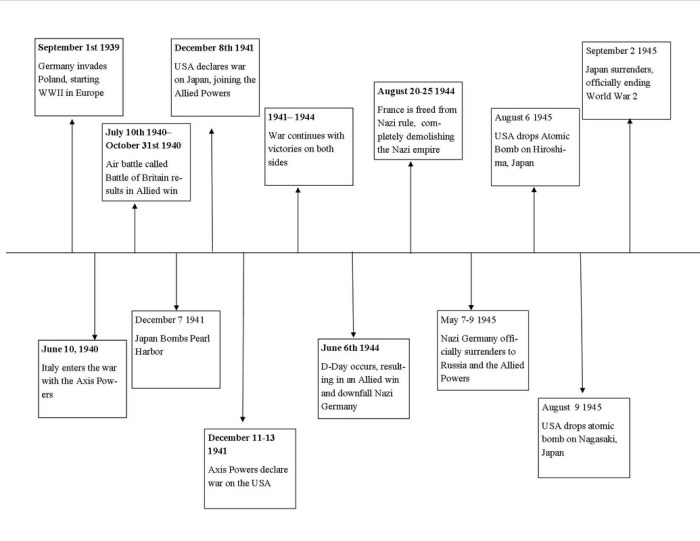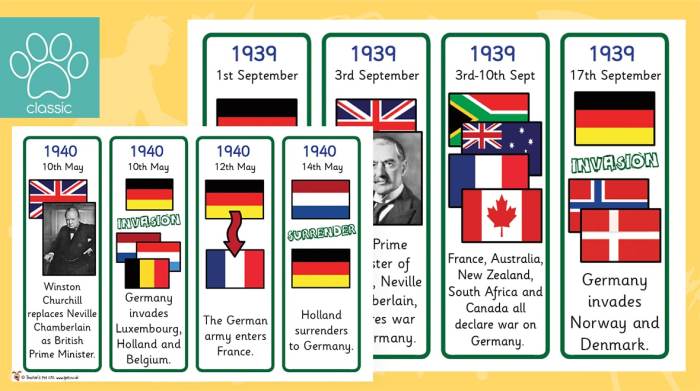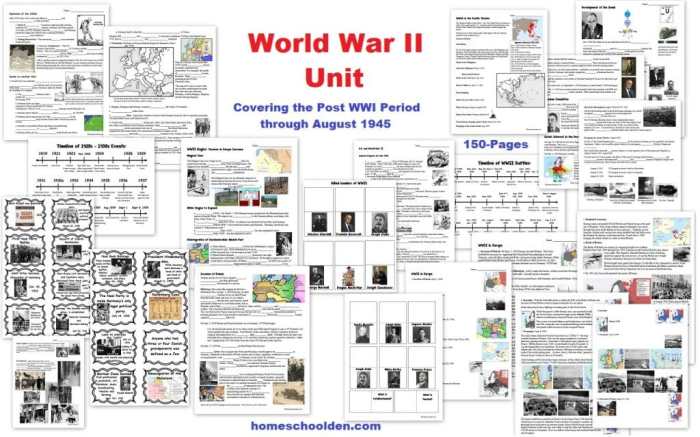World war 2 timeline worksheet – Embark on a captivating journey through time with the World War II Timeline Worksheet. This comprehensive resource unfolds the intricate tapestry of the conflict, providing a bird’s-eye view of its key battles, pivotal events, and profound societal impact.
Delve into the depths of World War II’s historical context, unraveling the complex web of alliances and ideologies that ignited the global inferno. Explore the defining battles and turning points that shaped the course of the war, chronicled in an interactive timeline that transports you to the heart of the conflict.
Historical Context

The outbreak of World War II in 1939 was a culmination of events and tensions that had been brewing for decades. The war’s origins can be traced back to the aftermath of World War I and the Treaty of Versailles, which left Germany weakened and resentful.
In the years leading up to World War II, several key factors contributed to the rise of fascism and militarism in Europe. The Great Depression of the 1930s created widespread economic hardship, which fueled political instability and extremism. The rise of totalitarian regimes in Germany, Italy, and Japan led to increased aggression and territorial expansionism.
Major Alliances
As tensions escalated, two major alliances emerged: the Axis powers, consisting of Germany, Italy, and Japan, and the Allied powers, consisting of Great Britain, France, the Soviet Union, and later the United States.
Ideological Divide
The war was also fueled by a clash of ideologies. The Axis powers espoused fascism, a form of authoritarianism that emphasized nationalism, militarism, and the suppression of individual rights. The Allied powers, on the other hand, represented democracy, liberalism, and the rule of law.
Key Battles and Events

World War II unfolded through a series of significant battles and events that shaped its course and outcomes. From the initial German invasion of Poland to the surrender of Japan, key confrontations and milestones marked the ebb and flow of the war.
The following interactive timeline provides a comprehensive overview of these critical events, capturing their dates, locations, and brief descriptions.
September 1, 1939: German Invasion of Poland
Marking the official start of World War II, Nazi Germany invaded Poland, triggering a chain of events that led to global conflict.
June 6, 1944: D-Day Landings
Allied forces launched a massive amphibious assault on the beaches of Normandy, France, opening a crucial front against Nazi-occupied Europe.
To comprehend the intricate events of World War II, a timeline worksheet proves invaluable. Understanding the progression of the war helps us grasp its complexities. Incidentally, Molly has a 2500 down payment , which may pique your interest in financial planning.
Nevertheless, returning to the subject of the worksheet, it offers a structured framework for studying the timeline of World War II, enhancing our understanding of this pivotal historical event.
August 6 and 9, 1945: Atomic Bombings of Hiroshima and Nagasaki
The United States dropped atomic bombs on the Japanese cities of Hiroshima and Nagasaki, hastening the end of the war and leaving a lasting legacy of devastation.
Impact on Society

World War II profoundly transformed global society, leaving an indelible mark on social, economic, and political landscapes. The conflict unleashed a maelstrom of human suffering and devastation, while simultaneously driving technological advancements and spurring social change.
Propaganda and Human Rights
Propaganda played a pivotal role in shaping public opinion and mobilizing populations during the war. Governments employed a variety of techniques, including posters, films, and radio broadcasts, to rally support and demonize the enemy. The war also witnessed a widespread disregard for human rights, with atrocities committed by all sides.
The Holocaust stands as a grim testament to the horrors that can result when human rights are trampled upon.
Technological Advancements
The war accelerated the development and adoption of new technologies. Radar, jet aircraft, and nuclear weapons were among the groundbreaking innovations that emerged during this period. These advancements had a profound impact on the course of the war and laid the foundation for future technological progress.
Social Change
The war also brought about significant social changes. Women entered the workforce in unprecedented numbers, taking on roles traditionally held by men. This shift had a lasting impact on gender roles and the economy. The war also led to the decolonization of many European colonies, paving the way for the rise of new nations and the reshaping of the global political order.
Post-War Legacy: World War 2 Timeline Worksheet

World War II left an enduring mark on the world. The war had profound consequences, both in the immediate aftermath and in the decades that followed.
One of the most significant legacies of the war was the formation of the United Nations. The UN was established in 1945 as a way to prevent future wars and promote international cooperation. The UN has played a vital role in maintaining peace and security around the world, and it continues to be an important force for good today.
Another major legacy of the war was the Cold War. The Cold War was a period of tension and conflict between the United States and the Soviet Union. The Cold War lasted for nearly 50 years, and it had a profound impact on the world.
The Cold War ended in 1991 with the collapse of the Soviet Union.
The United Nations
- Established in 1945 to prevent future wars and promote international cooperation.
- Has played a vital role in maintaining peace and security around the world.
- Continues to be an important force for good today.
The Cold War
- A period of tension and conflict between the United States and the Soviet Union.
- Lasted for nearly 50 years and had a profound impact on the world.
- Ended in 1991 with the collapse of the Soviet Union.
Educational Resources

Educating students about World War II is crucial for understanding its profound impact on the world. A well-designed worksheet can facilitate effective teaching and engage students in critical thinking.
An effective worksheet should incorporate:
Primary Source Documents
Including primary source documents, such as speeches, letters, or newspaper articles, allows students to analyze firsthand accounts and develop a deeper understanding of the events.
Discussion Questions
Thought-provoking discussion questions encourage students to engage with the material, form their own interpretations, and foster critical thinking skills.
Activities, World war 2 timeline worksheet
Interactive activities, such as creating timelines, analyzing maps, or conducting simulations, enhance student engagement and reinforce learning.
Visual Aids

Visual aids are crucial for understanding the complexities of World War II. They provide a tangible representation of the conflict, helping students visualize the vast scale and far-reaching impact of the war.
Maps
Create a series of maps that illustrate the major campaigns and territorial changes throughout the war. These maps should depict the movement of troops, the shifting front lines, and the areas that were occupied or liberated during the conflict.
Images and Videos
Provide students with a collection of images and videos that capture the events of the war. These could include photographs of battles, propaganda posters, newsreels, and personal accounts. By viewing these materials, students can gain a deeper understanding of the human experience during this tumultuous period.
FAQ
What is the purpose of this worksheet?
This worksheet is designed to provide a comprehensive overview of World War II, including its historical context, key battles, societal impact, and post-war legacy.
What are the benefits of using this worksheet?
This worksheet offers several benefits, including an interactive timeline, primary source documents, discussion questions, and activities that enhance understanding and engagement with the topic.
How can I use this worksheet in my classroom?
This worksheet can be incorporated into lesson plans as a supplement to textbooks, as a basis for class discussions, or as a self-guided learning resource for students.